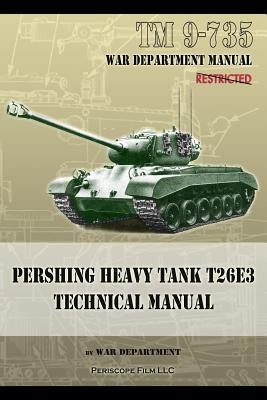
- We will send in 10–14 business days.
- Author: War Department
- Publisher: Periscope Film LLC
- ISBN-10: 1937684431
- ISBN-13: 9781937684433
- Format: 15.2 x 22.9 x 2.6 cm, minkšti viršeliai
- Language: English
- SAVE -10% with code: EXTRA
TM 9-735 Pershing Heavy Tank T26E3 Technical Manual (e-book) (used book) | bookbook.eu
Reviews
Description
The Pershing was the first operational heavy tank of the US Army; originally the T26, the tank was eventually redesignated the M26 Pershing medium tank. Named after General John J. Pershing who led the American Expeditionary Force in Europe in World War I, it was briefly used both in World War II and in the Korean War. Intended as an improvement of the M4 Sherman, the prolonged time of development meant only a small number saw combat in the European theater, most notably the 9th Armored Division's dramatic dash to take the Bridge at Remagen.On December 22nd, 1944, while the battle still raged, the brand new T26E3 tanks were ordered to be deployed to Europe. Twenty were sent in the first shipment, arriving at the port of Antwerp in January of 1945. They were given to the 1st Army, split between the 3rd and 9th Armored Divisions. A total of 310 T26E3 tanks would be sent to Europe before VE Day, but only the first twenty would see any combat action. Created in 1945, this technical manual reveals a great deal about the T26E3's design and capabilities. Intended as a manual for those charged with operation and maintenance, it details many aspects of its engine, cooling, power and other systems. Originally labeled restricted, this manual was declassified long ago and is here reprinted in book form. Care has been taken to preserve the integrity of the text.
EXTRA 10 % discount with code: EXTRA
The promotion ends in 22d.06:39:49
The discount code is valid when purchasing from 10 €. Discounts do not stack.
- Author: War Department
- Publisher: Periscope Film LLC
- ISBN-10: 1937684431
- ISBN-13: 9781937684433
- Format: 15.2 x 22.9 x 2.6 cm, minkšti viršeliai
- Language: English English
The Pershing was the first operational heavy tank of the US Army; originally the T26, the tank was eventually redesignated the M26 Pershing medium tank. Named after General John J. Pershing who led the American Expeditionary Force in Europe in World War I, it was briefly used both in World War II and in the Korean War. Intended as an improvement of the M4 Sherman, the prolonged time of development meant only a small number saw combat in the European theater, most notably the 9th Armored Division's dramatic dash to take the Bridge at Remagen.On December 22nd, 1944, while the battle still raged, the brand new T26E3 tanks were ordered to be deployed to Europe. Twenty were sent in the first shipment, arriving at the port of Antwerp in January of 1945. They were given to the 1st Army, split between the 3rd and 9th Armored Divisions. A total of 310 T26E3 tanks would be sent to Europe before VE Day, but only the first twenty would see any combat action. Created in 1945, this technical manual reveals a great deal about the T26E3's design and capabilities. Intended as a manual for those charged with operation and maintenance, it details many aspects of its engine, cooling, power and other systems. Originally labeled restricted, this manual was declassified long ago and is here reprinted in book form. Care has been taken to preserve the integrity of the text.


Reviews